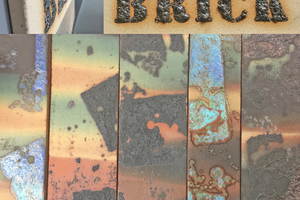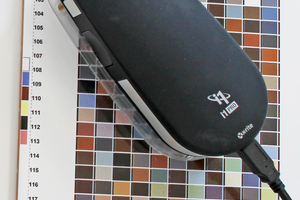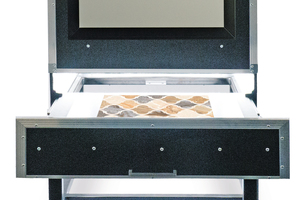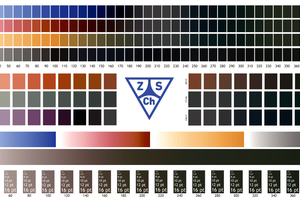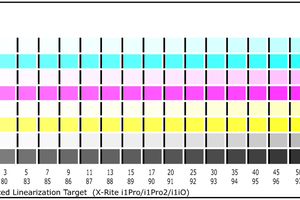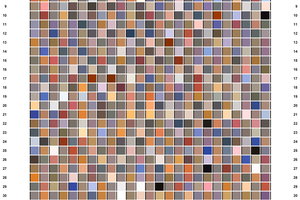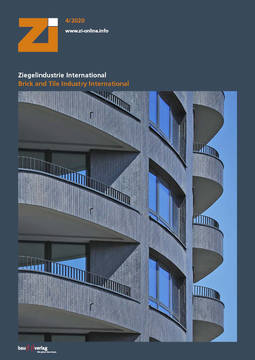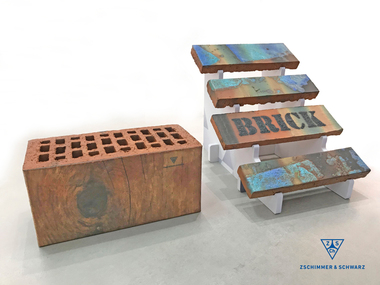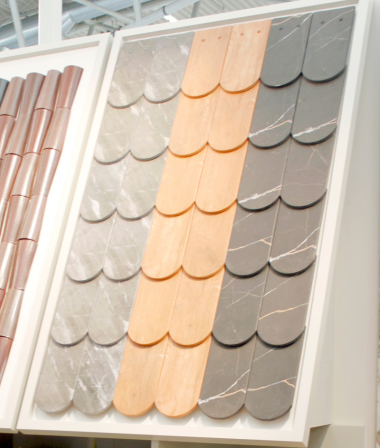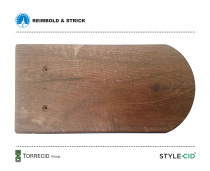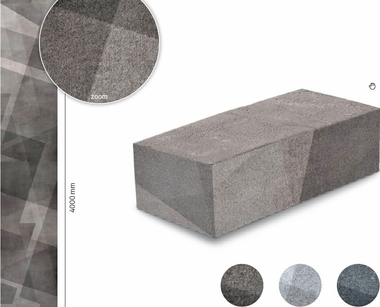Digital printing –
options and challenges in heavy clay ceramics (2)
In the 6/2019 edition of Zi Brick and Tile Industry International, the first part of this article informed readers about the technical aspects of digital printing systems. This part of the article examines the necessary preparatory work and explains the file creation process. All designs to be produced must first be created on a computer. This important step is explained in further detail in the following.
1 Options for digital decoration
In addition to the wide selection of digital printing inks in colour shades ranging from blue to brown, pink, yellow and beige all the way to black, Zschimmer & Schwarz also offers various digital print effects. These effects are marketed under the name Trucolor EF. They include texture, matte, gloss or lustre effects as well as purely technical products such as a digital printing ink with anti-slip properties.
The Trucolor EF product range is complemented by the Trubond series. Trubond includes adhesives that are applied either by means of a custom-designed printer or in the last printing line of a conventional printer. Once the adhesive has been applied, any kind of granulate can be sprinkled on the surface. The granulate will stick to the adhesive, excess material is suctioned away and reused.
Different examples of application are shown in »1.
2 Additional requirements for process integration
The workplace used to create and edit the required print files is a particular challenge in respect of process integration. The following items are required for an ideally equipped workplace:
standardized light, constant light conditions
suitable monitor
high-performance PC or Mac
colorimeter
2.1 Standardized light, constant light conditions
It should be ensured that the workplace can be completely darkened and that there is no incidence of extraneous light, e.g. from windows. Walls should be painted in a neutral grey and the illumination should have a broad light spectrum, e.g. by the use of a D50 light source.
2.2 Suitable monitor
A suitable monitor is essential for achieving the best possible result. The monitor must ensure homogeneous colour representation across the full screen, and the screen size should not be too small. Other important features are the monitor’s reproducible colour range and functions for calibration and adjustment of contrast and brightness. No pure white (e.g. lab coats) or bright surfaces that may affect the display of colours due to reflections should be present in the direct vicinity of the monitor.
2.3 High-performance PC or Mac
The PC or Mac should offer a performance that allows the trouble-free editing of image files of up to 5 GB. Image editing software like Adobe Photoshop is imperative. The computer or Mac should ideally also be equipped with colour management software.
2.4 Colorimeter
Colorimeters are used in the graphic industry to measure colour fields with a defined light colour and depending on the type of sensor or measurement in accordance with the standard. There are currently two colorimeters on the market that are used in heavy clay ceramics applications:
the i1Pro spectrophotometer (»2) by X-Rite and
the Rapid Spectro Cube (RSC, »3) by ColorGATE Digital Output Solutions GmbH
The difference between the two devices is in the measurement method. The i1Pro measures each individual colour field of the previously generated test chart (see below for a more detailed explanation) and is in contact with the surface during the measurement, while the Cube (RSC) measures the entire test chart in a single contact-free work step.
Measuring the chart with the i1Pro takes longer than with the Cube (RSC) and may deliver inaccurate measurements for textured or reflective surfaces. This inaccurate measurement data may be unusable for the colour management to be carried out in the next step. The different measuring technology of the Cube (RFC) allows it to also capture measurement data from technically demanding surfaces. This data can then be used for colour management (ICC profile [International Color Consortium], also called colour profile) in a way that the appearance of the colours on the print results accords with the sensory impression of human colour perception.
3 Can I print a photo?
It depends - you cannot just send a file to the digital printer and obtain a satisfactory result. It is, however, possible to print photos with the necessary preparations and subject to the limitations of the available colour space. Good quality and reproducible results with a printer require the possible colour space to be edited in a way that renders it interpretable for Photoshop and other colour management programmes. This is done by creating so-called ICC profiles.
The colour space in photo printing comprises approximately 400 000 colours. Printing usually relies on organic colours that allow for more colourful images. In comparison, newspaper printing has a much smaller colour space consisting of 80 000 colours. This is due to the specific properties of the paper used.
A standard printer for private use comes with the colour palette that can be derived from the process colours CMYK, the RIP (Raster Image Process) is carried out in a standardized manner. For ink suppliers, the colour definition of CMYK is specified in ISO 2846. While this does not guarantee the exact same result for all paper printers, it does allow fairly similar results to be achieved. CMYK stands for the process colours Cyan, Magenta, Yellow and Black (key colour) and is a subtractive colour model.
Because colour behaviour strongly depends on the process, it is not possible to work in accordance with ISO 2846 in the ceramic field. To offer a producible colour palette for ceramics, the traditional CMYK model had to be modified. Owing to the firing temperature used for ceramics, it is necessary to use inorganic pigments, which can only be printed if they satisfy the required grinding fineness and stability. Magenta is replaced by a red-brownish colour. For areas that require a lush green that cannot be achieved by mixing, it is recommended to work directly with a green digital printing ink.
Choosing the right combination of digital printing inks requires an integrated assessment of the whole process. Yellow pigments, for example, may turn out fairly pale or have a green cast if fired at higher temperatures. A beige or orange colour can deliver better outcomes.
Digital printing on ceramics usually has a colour range of between 40 000 and 80 000 colours for wall tiles and between 10 000 and 30 000 colours for flooring. The colour range always depends on the specific glaze and configuration of digital printing inks. The initial results in heavy clay ceramics have confirmed that a colour palette similar to the one used for floor tiles is achievable.
4 Use of colour management software in the ceramics industry
Colour management software is not used for image editing but supports the transfer of designs from one colour space to another and thereby allows for a reproducible rendering of colours. It is used to standardize work processes and improves the quality of the print files.
Another point is that the colour behaviour of organic colour pigment inks is usually linear and thereby easier to calculate for image editing software. In comparison to paper printing, the inks with inorganic pigments used in ceramic digital printing do not behave in a linear manner. It is therefore not possible to simply adopt software solutions for printing on paper. ColorGATE Digital Output Solutions GmbH has been examining the behaviour of ceramic digital printing inks over the last couple of years and has successfully optimized its “Ceramic Productionserver” software for ceramic applications.
So-called ICC profiles that ensure a true-colour process from the master template to reproduction are generated and form the working basis. Assuming that 80 000 colours can be achieved in the process, not all of them can be defined by the actual physical measurement. Hence, the higher the number of colour fields in a profile chart, the more precise the description of the colour space. The general rule is that 500 measurement fields can be assumed for each colour, with the result that 2 000 fields within one colour mix are available to describe the colour space of a 4-colour print. This quantity of measured colour values is used to find an ideal between the actual measured value and the calculated value.
Since no two processes are 100% identical, the ICC colour profiles have to be generated individually for every single process. A second printer from the same manufacturer that is filled with the same digital printing inks will require its own profile. If an optimized process in production is to be established for the purposes of colour management, a new ICC profile will have to be created for each process modification. An ICC profile is generated in three steps:
The first step is the software-based linearization (»4), during which the individual colours are printed with an ink quantity that increases in even steps from 0 to 100%. The generated linearization chart is measured after firing and analysed using suitable software. The resulting measurement data are used to derive a curve that depicts the actual printing behaviour. This makes it possible to optimize the print output with the result that the individual digital printing ink channels show a linear behaviour
The second step consists in printing a so-called “ink limit” (»5). This serves the purpose of evaluating the print quality resulting from the application of the maximum ink quantity
The last step consists in printing a profile chart (»6). This is a mosaic made of defined mixed colours, where the individual mixed colours are referred to as patches. The size of such a colour chart depends on the number of colours used. 500 patches for each colour are recommended. Depending on the measurement device, a patch can measure between 1 mm and 1 cm in size
If the source colour space of an image is known and the colours can be achieved within the target colour space, an image can be converted so that its colour after printing appears identical to the source image. It is, however, not always possible to convert images, designs or print files into all conceivable processes.
5 Outlook for future applications
All digital printing inks currently used in ceramic processes are solvent-based. In some cases, this leads to difficulties when they are used in combination with a water-based system, e.g. with the glazes and engobes used. The solvents cannot be mixed with water and may have a water-repelling effect when combined with glaze and engobe coats. Additives made by Zschimmer & Schwarz can be added to the water-based system, i.e. the engobe or glaze, to minimize or completely eliminate the water-repelling effect.
Water-based digital printing colours will play a bigger role in the future. The development of water-compatible print heads remains a great challenge for the manufacturers, with industrial-scale trials already being conducted. The advantages of water-based printing colours include a higher definition with clearer contours, the option of printing directly on wet surfaces and improved firing characteristics.
Digital engobing and glazing will increase in significance owing to their resource-friendly application. There are currently different developments in the type of application. Trials are being conducted with piezo- and valve-controlled print heads for the glazes and engobes. At the moment, this system is only worthwhile if larger production runs are made with the same engobe or glaze. It is, however, not possible to use standardized glazes or engobes for digital application. Especially in the case of valve technology, the required engobe or glaze has to be configured to customer-specific rheological properties.
Zschimmer & Schwarz GmbH & Co KG Chemische Fabriken
www.zschimmer-schwarz.com

